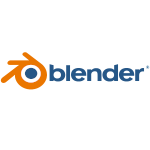Blender: free program for 3D drawing, modeling, animation, video creation/editing
History: (source wikipedia)
The program was originally developed in the Netherlands. Due to its different operation, it was not among the most well-known programs, but it has a loyal group of users. When the program was only available through purchase, it was not a resounding success. As a result, development was stopped at one point and the program was no longer available. This led to many negative reactions from loyal users. The company agreed to make the source code public if they could present 100,000 euros to recompensate the investors. The Blender community raised this amount in just 7 weeks, after which the source code of the program was made public.This allowed the development to continue as an open source program.
Blender’s capabilities include the following:
Various modeling capabilities, such as: polygon meshes, NURBS, metaballs, and vector fonts.
Reading and writing various 3D file formats, such as those from Wings 3D, 3D Studio, LightWave, etc.
Creating animations, with: inverse kinematics, skeletal and lattice deformations, keyframes, nonlinear animation, constraints, vertex weighting, and static or dynamic particles that take objects into account.
Creating games, this is very basic though but can be extended with Python.
An integrated non-linear video editor. In it one can mix video clips with sound and add effects. Thanks to the “Camera Tracking” feature, where one mimics the movement of the real camera with the Blender Camera through an algorithm, one can also easily mix 3D content with real images. These digital additions are also called VFX (Visual Effects). Multiple features for this were added, extensively tested and improved during the “Mango Open Movie Project”, where people only used Blender and other open source software to create and add special effects to a short film.


